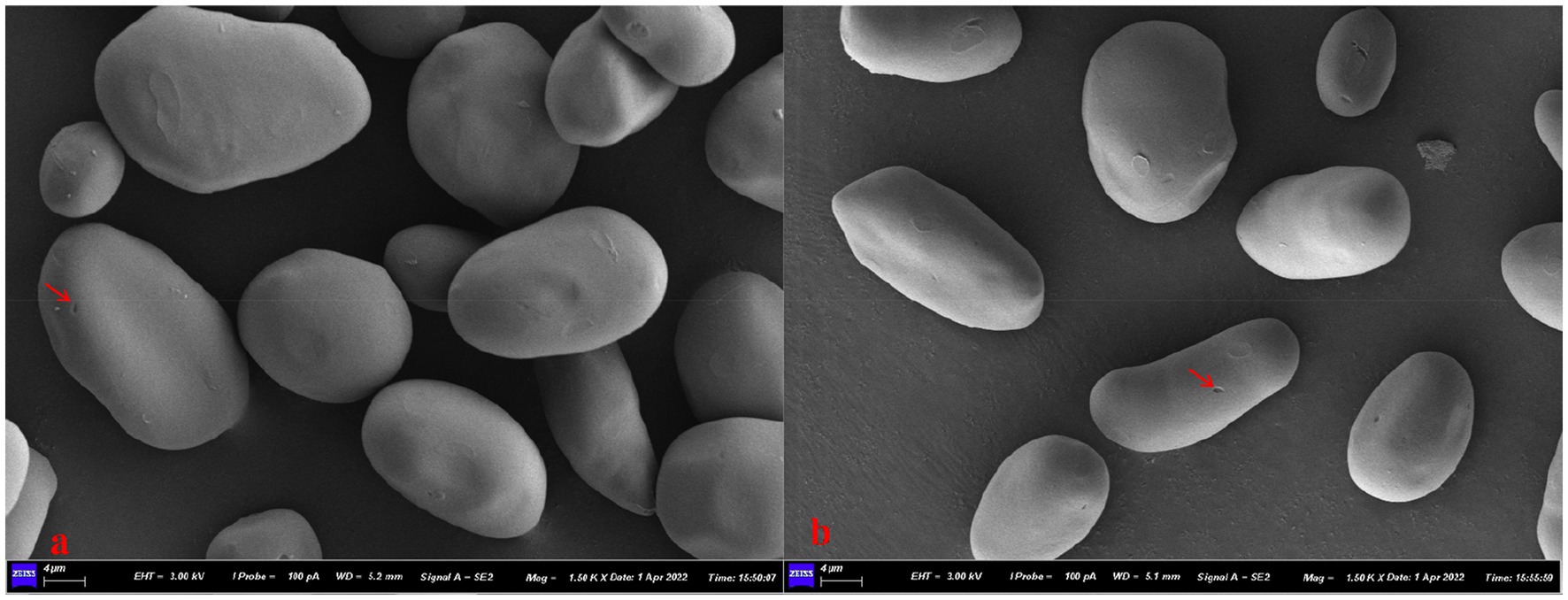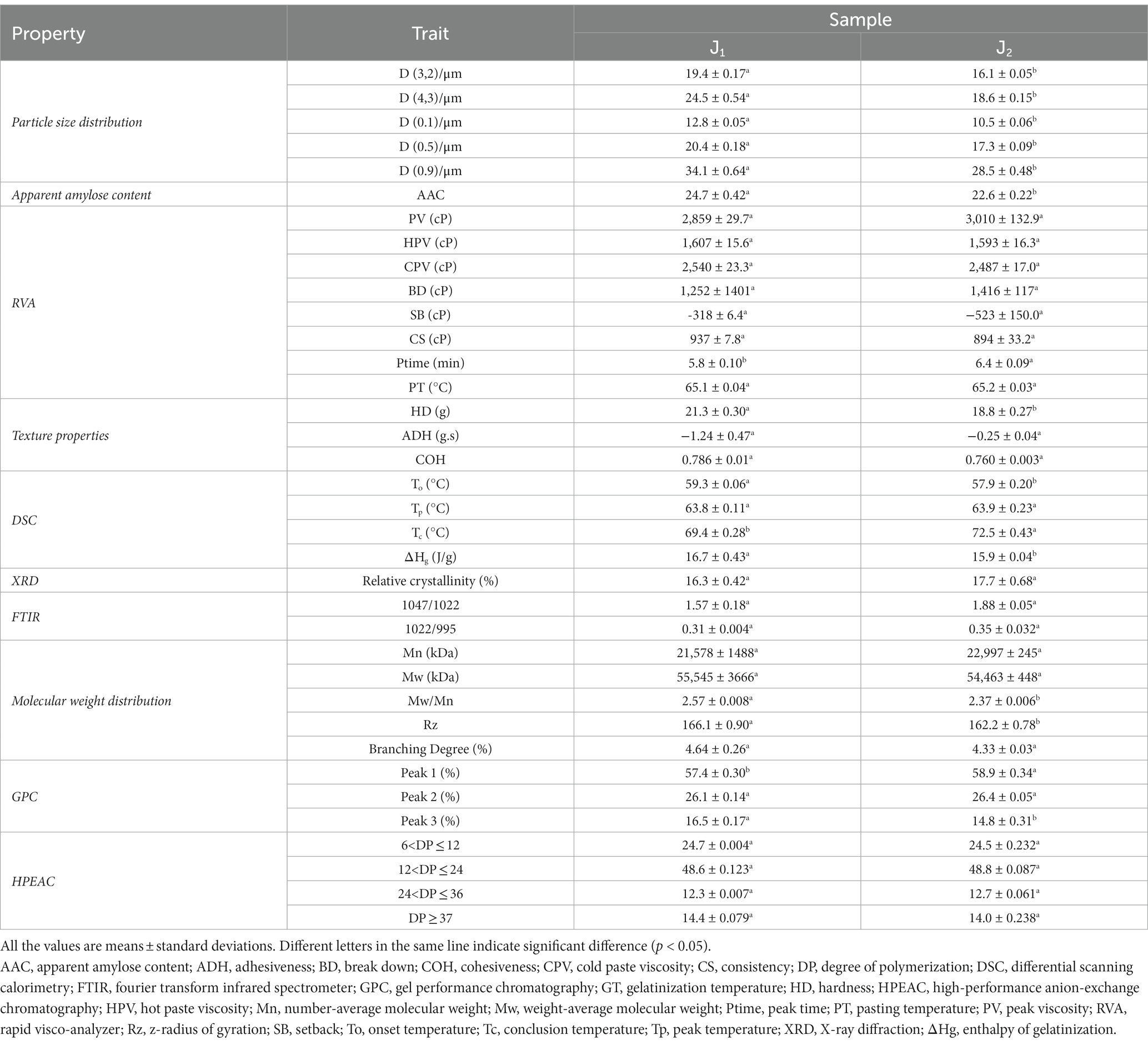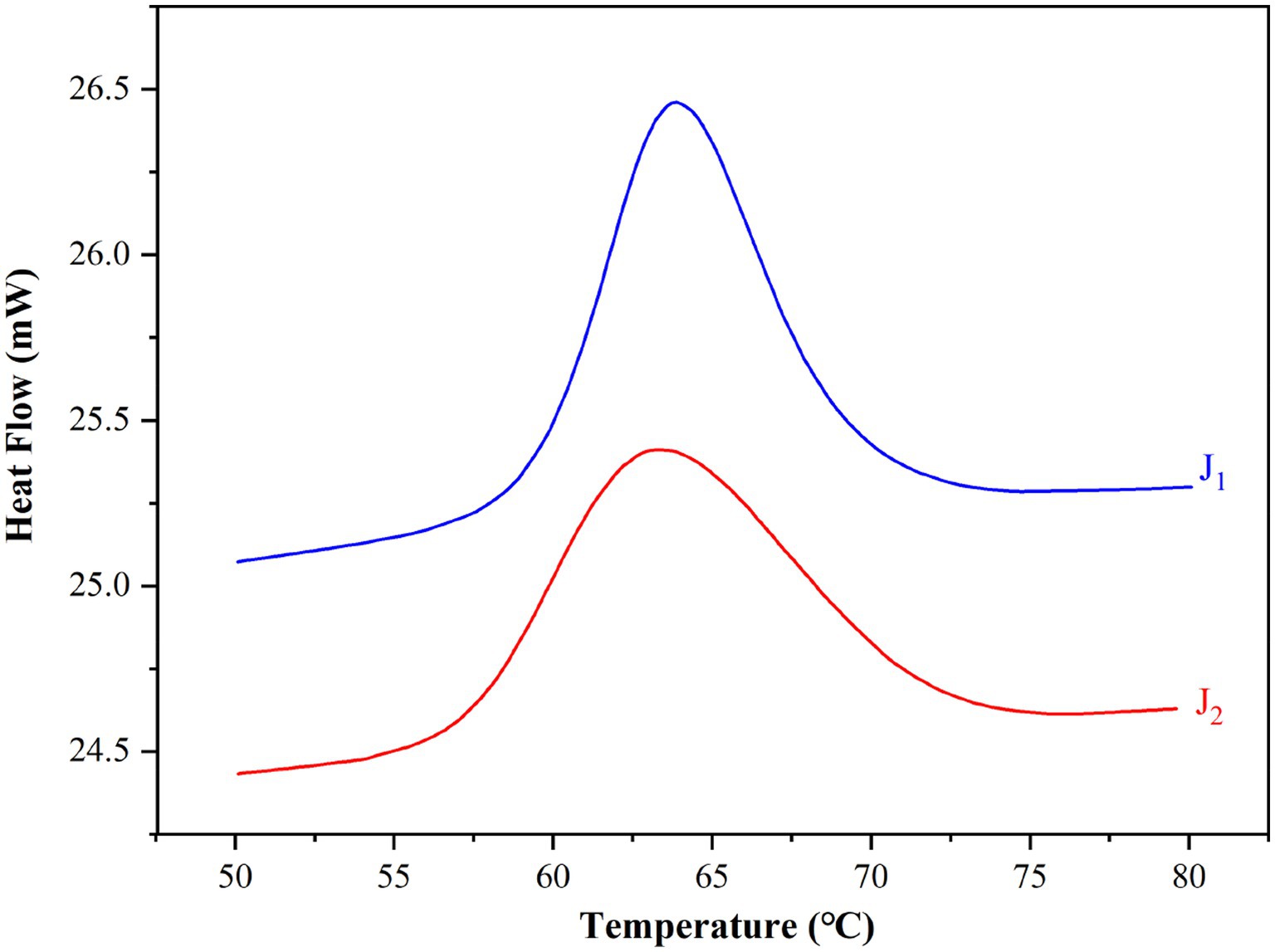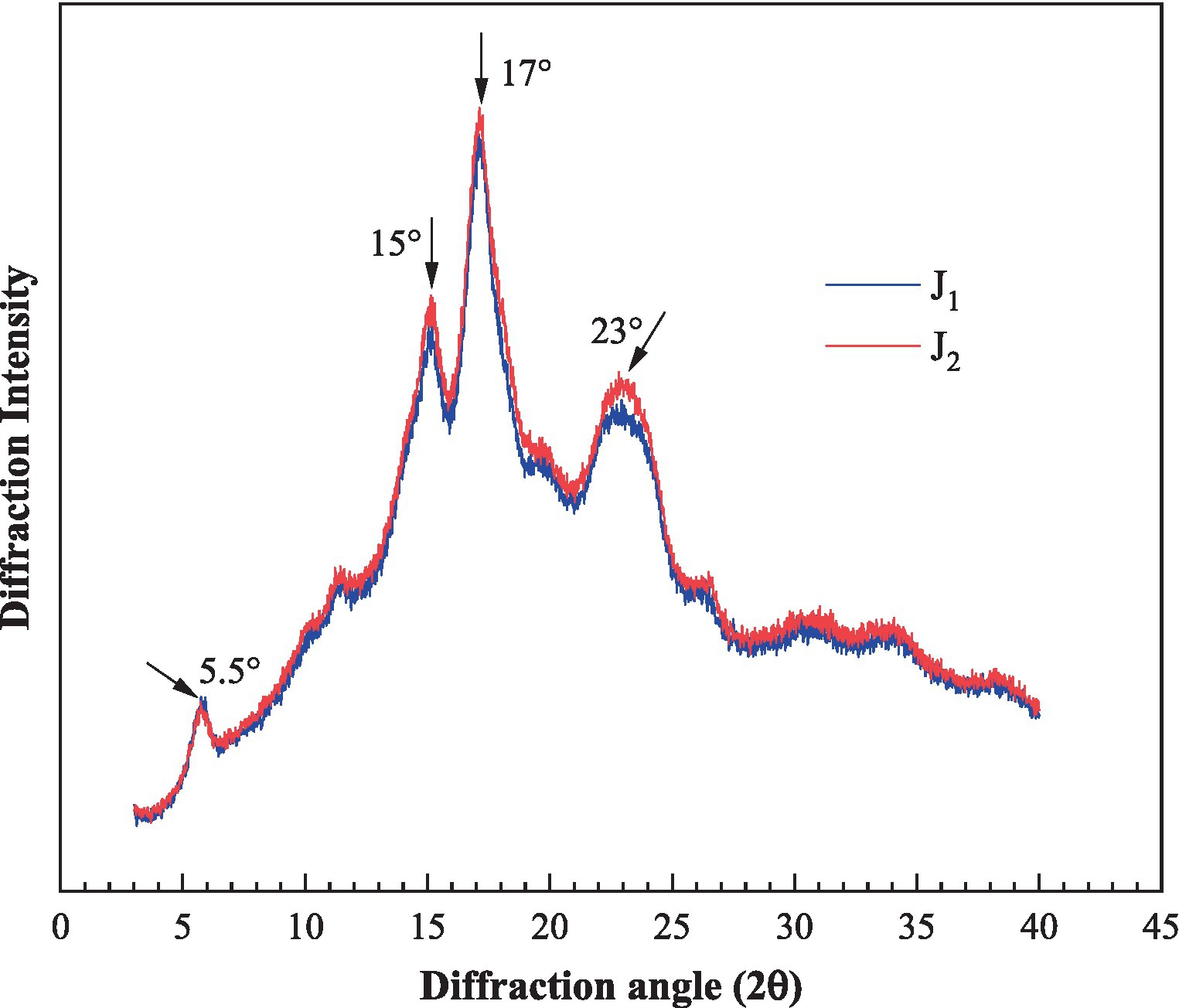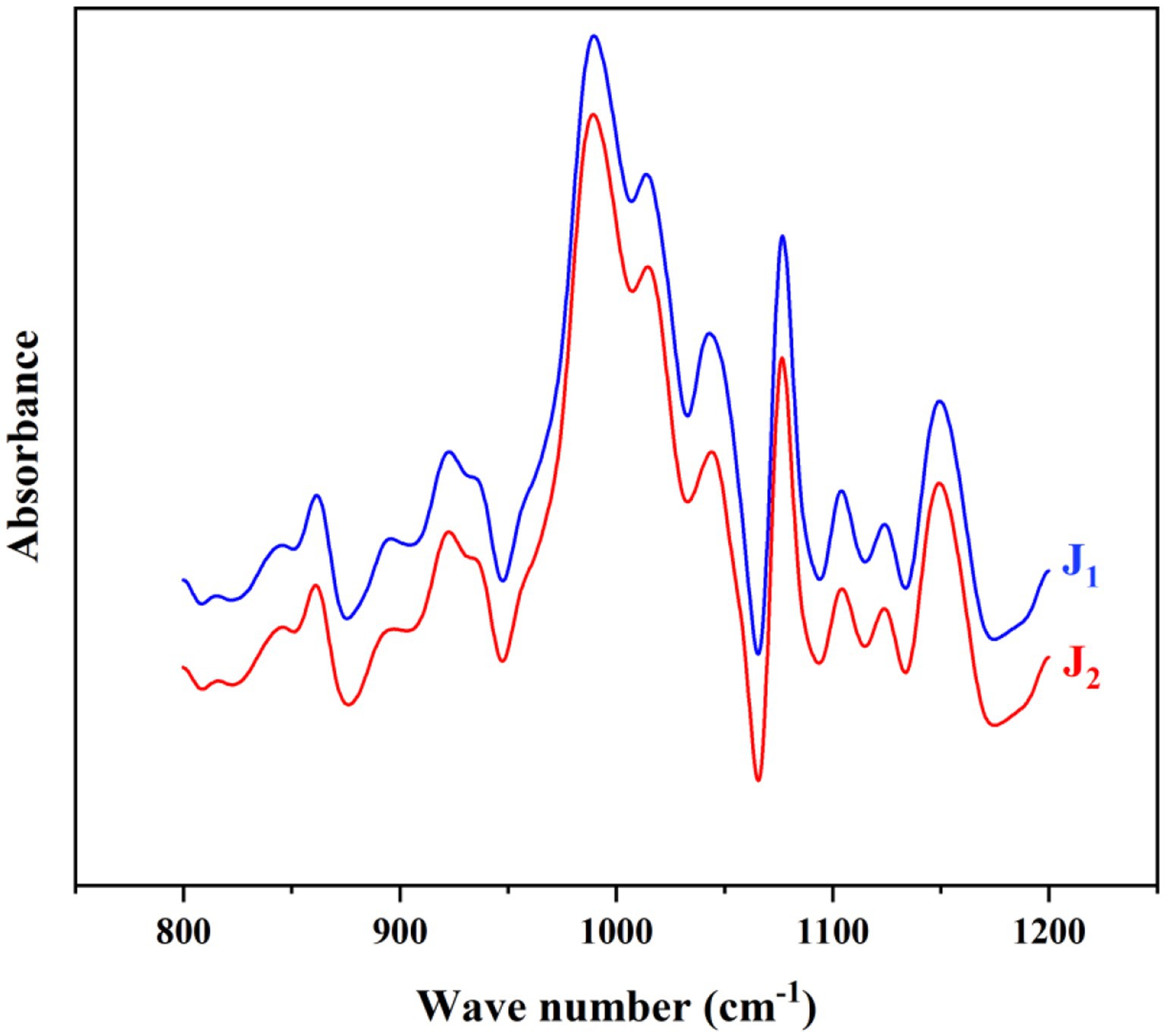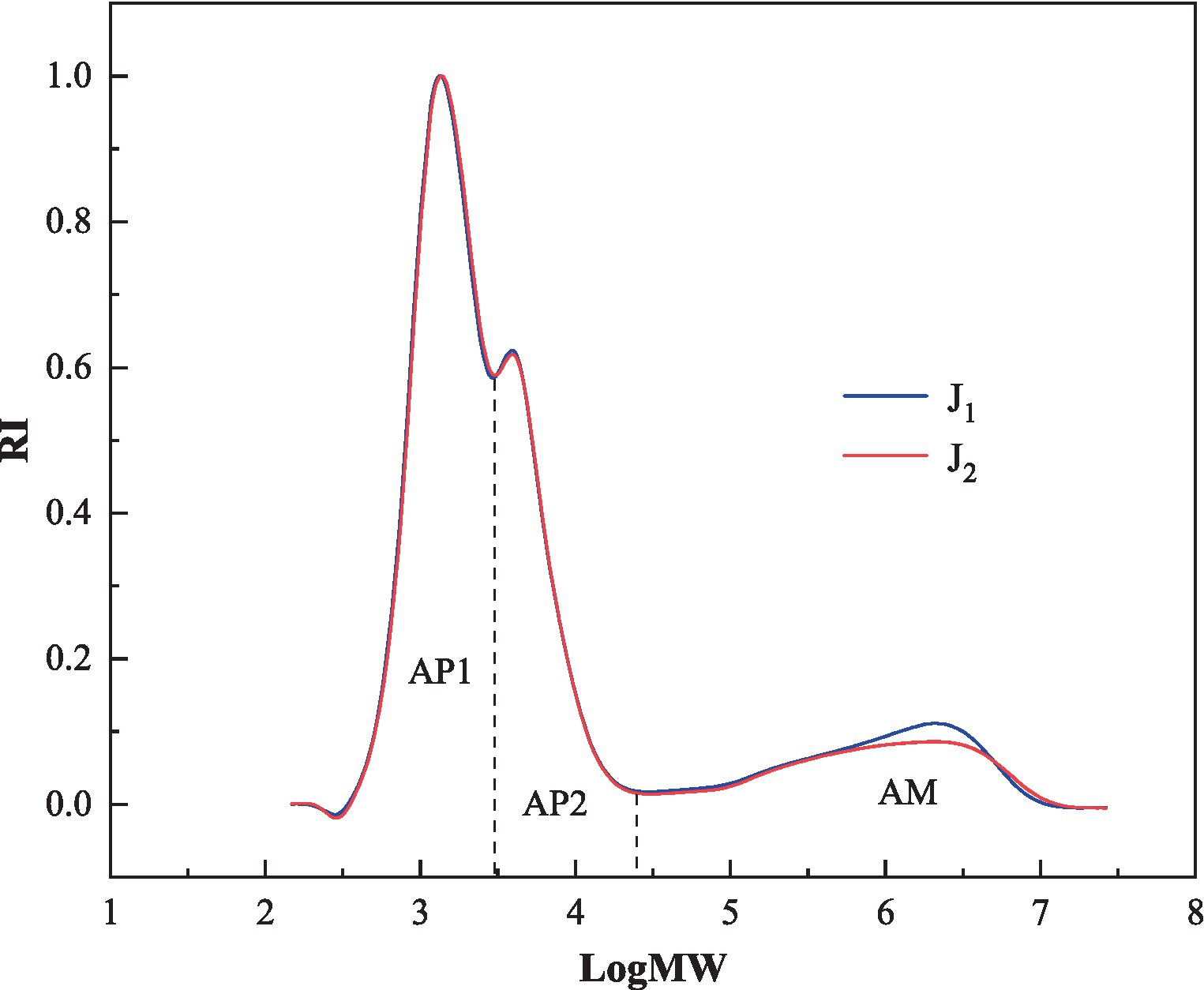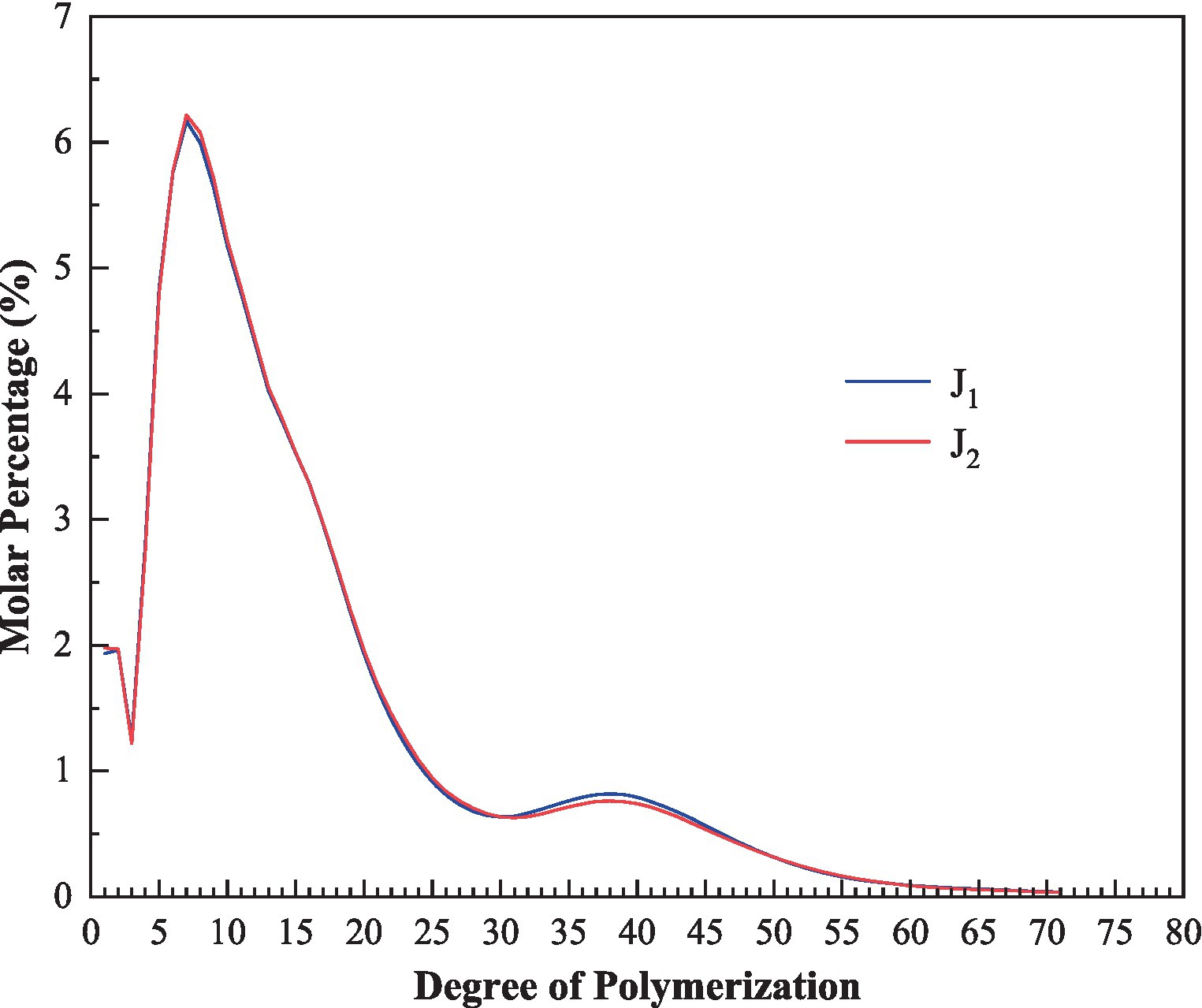- 1Key Laboratory of Plant Resource Conservation and Germplasm Innovation in Mountainous Region (Ministry of Education), Collaborative Innovation Center for Mountain Ecology & Agro-Bioengineering (CICMEAB), Institute of Agro-Bioengineering, College of Life Sciences, Guizhou University, Guiyang, Guizhou, China
- 2Biotechnology and Food Engineering Program, Guangdong Technion-Israel Institute of Technology, Shantou, China
- 3State Key Laboratory for Managing Biotic and Chemical Threats to the Quality and Safety of Agro-Products, Institute of Food Sciences, Zhejiang Academy of Agricultural Sciences, Hangzhou, China
- 4Faculty of Biotechnology and Food Engineering, Technion–Israel Institute of Technology, Haifa, Israel
Introduction: Bracken fern (Pteridium aquilinum) starch is a non-mainstream, litter-researched starch, thus the starch characteristics remain largely unknown.
Methods: The structural and physicochemical properties of two bracken starches were systematically investigated, by use of various techniques that routinely applied in starch analysis.
Results and Discussion: The starches had amylose contents of 22.6 and 24.7%, respectively. The starch granules possessed C-type polymorph with D (4,3) ranging from 18.6 to 24.5 μm. During gelatinization event, the bracken starches showed lower viscosity than typical for rice starch, and lower gelatinization temperature than typical for cereal starches. After gelatinization event, bracken starches formed much softer and sticky gel than rice and potato starch. The molecular weight and branching degree (indexed by Mw, Mn and Rz values) of bracken starches were much higher than starches of many other sources. The branch chain length distributions showed that the bracken starches were structurally similar to some rice varieties (e. g. BP033, Beihan 1#), as reflected by proportions of A, B1, B2, and B3 chains. Notable differences in some starch traits between the two bracken starches were recorded, e. g. amylose content, gel hardness, gelatinization temperature and traits of structural properties. This study provides useful information on the utilization of bracken starch in both food and non-food industries.
1. Introduction
Bracken fern (Pteridium aquilinum) is widely distributed in South and Central America, Oceania and Southeast Asia (1). There is a long history of human consumption of bracken fern as a major dietary source to obtain starch and fiber (2). Nowadays, bracken fern is not only an important ornamental plant which is widely used in garden landscaping, but also still serves as a food material in many countries. In Japan and China, the tender bud of bracken fern cooked as vegetable is a popular delicacy in Spring (3). In Southwest China, a kind of sticky cake made from bracken starch, namely ‘Jue Ba’, is a traditional and popular local food. ‘Jue Ba’ is usually cooked with cured pork, or directly eaten as a snack after toasted.
Despite its utilization as human food, bracken fern still remains to be a wild plant, there is no documentation regarding its cultivation yet. Studies on bracken fern are limited, and most of literature focused on the bracken toxins (1). Investigations into the nutrients of bracken fern are few. Previously, it is reported that bracken fern contains various nutrients, such like protein, carbohydrates, fat, vitamins, trace minerals and carotenoids (4). It was found that abundant starch granules accumulate in parenchymal cells of bracken fern rhizome (5), an up to 45.29% total starch content was reported for bracken fern (6). However, the characteristics of starch from this botanical source remain largely unknown. Some properties including morphological, crystal, pasting and in vitro digestion properties had been investigated, using only one sample obtained in China (5), but the molecular structure and many important physicochemical properties still remain undetermined.
There are mainly two types of polysaccharides in starch: amylose and amylopectin. Amylose is mostly linear with few branches while amylopectin is highly branched. Many factors can affect starch physicochemical properties, including the shape and size of starch granules, amylose/amylopectin ratio, and fine structure of amylopectin (7, 8). Fully knowing the physicochemical and structural characteristics of a starch is a prerequisite for further developing its utilization in food and non-food industries. For example, crop grains with lower amylose content are usually favored in fermentation to produce vinegar and white wine, and the strength of the starch-based film is largely determined by the molecular weight of amylose and amylopectin. In order to accurately describe starch quality, several indexes have been established and routinely used in main-stream starches, i.e., apparent amylose content (AAC), Rapid Visco Analyzer (RVA) pasting viscosity, gel consistency (GC), textural properties and thermal properties (9).
In this study, starch samples were extracted from the rhizome of two bracken ferns, which were grown in different environments. Then, the structure and physicochemical properties of these two starch samples were systematically investigated. The aim of this study is to broaden our knowledge on bracken starch characteristics, in order to provide a guideline for later exploring its potential utilization in food and non-food industry.
2. Materials and methods
2.1. Materials
Two bracken starch samples were used in this study. One (J1) was extracted from the rhizome of bracken fern grown in Yongxing City, Hunan province, China (113°E, 26°N) and the other (J2) was extracted from the rhizome of bracken fern grown in Huaihua City, Hunan province, China (109°E, 27°N). Both starch samples were extracted by the suppliers and sold online. J1 was purchased from online shop“Yongxing Lao Jia Tu Te Chan” and J2 was bought from “Xun Wei You Pin Te Chan Dian.”
2.2. Scanning electron microscopy
The starch granules were gold coated, then an SEM (Scanning Electron Microscope VEGA3, TESCAN, Brno, Czech Republic) was used to observe the morphology of the starch granules, with a voltage of 3.00 k V and a magnification of 1.50 k X.
2.3. Apparent amylose content
Apparent amylose content was measured according to the previously reported method (9). In brief, 100 mg starch sample was weighed into a 100 mL measuring flask, then dispersed with 1 mL of 95% ethanol. Next, 9 mL of NaOH (1 mol/L) was added, and the starch solution was gently shaken to avoid major lumps. The solution was boiled till completely clear. After cooling, the solution was diluted to 100 mL with distilled water. Finally, 500 μL of sample solution was well mixed with 200 μL of I2-KI (0.2–2%), 100 μL acetic acid (1 mol/L) and 9 mL distilled water in a 15 mL centrifugal tube. This final mixture was kept at room temperature for 10 min before measured by an spectrometer (UV 1800PC, Jinghua Instruments, Shanghai, China), at a wavelength of 620 nm. A standard curve was made simultaneously by using standard amylose (A0512, Sigma-Aldrich, Shanghai, China) and amylopectin (10,120, Sigma-Aldrich, Shanghai, China).
2.4. Particle size distribution
A laser diffraction particle size analyzer (S3500, Microtrac, Montgomeryville, PA, United States) was used to determine the particle size distribution of the starch samples, according to the manufacturer’s protocol.
2.5. Crystal properties
An X-ray diffractometer (3 kW/*D8 ADVANCE Da Vinci, Bruker, Karlsruhe, Germany) was used to reveal the diffraction patterns of starch samples. An X-ray tube Cu-Kα (nickel filter) at 40 kV and 40 mA was used as the X-ray source. The angular range of the diffraction angle (2θ) was 5°-40° with a step interval of 0.02°.
2.6. Pasting properties
A rapid visco analyzer (RVA4500, Perten Instruments, Hägersten, Sweden) equipped with Thermocline for Windows software was used to measure pasting properties. In brief, starch sample (3 g, 12% moisture basis) was mixed with 25 mL distilled water in a RVA sample can. The starch solution was heated following a temperature program: held at 50°C for 1 min, heated to 95°C in 3.8 min, and kept at 95°C for 10 min, cooling down to 50°C in 3.8 min and maintained at 50°C for 2 min. The peak time (Ptime), pasting temperature (PT), peak viscosity (PV), hot paste viscosity (HPV), cool paste viscosity (CPV) and the derivative parameters breakdown viscosity (BD = PV − HPV), setback viscosity (SB = CPV− PV), consistency (CS = CPV− HPV) were recorded or calculated.
2.7. Textural properties
The starch gel formed after RVA test was sealed in the sample can by Parafilm™ and kept at 4°C for 24 h. Then, a TA-XT2i Texture Analyzer (Stable Micro Systems, Godalming, United Kingdom) equipped with Texture Expert software (version 2.1) was used to measure the textural properties. The gel samples were pressed twice by a flat-ended, 5 mm diametered cylindrical probe for 10 mm distance at a speed of 1.0 mm/s. Hardness (HD), adhesiveness (ADH) and cohesiveness (COH) were recorded by the software.
2.8. Thermal properties
Thermal properties were measured by differential scanning calorimetry (Discovery DSC 25, TA Instruments, New Castle, DE, United States). In brief, starch sample (2 mg, dry basis) was mixed with 6 μL distilled water in an aluminum sample pan. The sample pan was hermetically sealed and equilibrated at room temperature for at least 2 h, before being heated from 30°C to 110°C at a rate of 10°C/min. An empty sealed pan was used as a reference. Onset (To), peak (Tp), conclusion (Tc) temperatures and enthalpy of gelatinization (ΔHg) were calculated using the Universal Analysis Program, Version 1.9D (TA Instruments).
2.9. Fourier transform infrared (FTIR) spectrum analysis
A Nicolet iZ-10 FTIR instrument (Thermo Fisher Scientific, Waltham, MA, United States) was used to scan starch samples for fourier transform infrared spectra. Starch sample (5 mg) was mixed with 250 mg potassium bromide and pressed into film-coated tablet. The potassium bromide was considered as the background of the tablet. Wavenumbers from 400 to 4,000 cm−1 were measured at 4 cm−1 spectral resolution over 32 scans. The molecular structure of starch was calculated based on the absorbance ratio of 1047/1022 cm−1, 1,022/995 cm−1.
2.10. Branch chain-length distribution
The branch chain-length distribution of amylopectin was analyzed by high-performance anion-exchange chromatography (HPAEC) on a CarboPac PA-100 anion-exchange column (4.0*250 mm, Dionex) using a pulsed amperometric detector (PAD, Dionex ICS 5000 system). Data were acquired on the ICS5000 (Thermo Fisher Scientific, Waltham, MA, United States), and processed using chromeleon 7.2 CDS (Thermo Fisher Scientific, Waltham, MA, United States).
2.11. Molecular weight distribution analysis
Starch molecular weight was measured by a gel permeation chromatography-refractive index-multiangle laser light scattering detector (GPC-RI-MALLS). The differential refractive index detector (Optilab T-rEX, Wyatt Technology Co., Santa Barbara, CA, United States) was equipped with two tandem columns (300 × 8 mm, Shodex OH-pak SB-805 and 803, Showa Denko K.K., Tokyo, Japan). The data were acquired and processed using ASTRA6.1 software (Wyatt, Santa Barbara, CA, United States).
2.12. Average degree of branching
Average degree of branching was determined using a Bruker BioSpin GmbH NMR spectrometer equipped with a tempering unit. Starch sample (10 mg) was mixed with 1 mL of deuterated dimethyl sulfoxide-d6 (DMSO-d6) and fully dissolved at 80°C overnight. The mixture was centrifuged at 12,000 rpm and the supernatant was taken and pipetted into an NMR tube. The 1H NMR scanning was performed 32 times, at a Larmor frequency of 500.23 MHz. Data were collected and analyzed with MestReNova. Average DB was calculated with Equation: DB (%) = (I-1,6) / (I-1,6 + I-1,4)*100, where I-1,6 is the integrated signal at 4.77 ppm and I-1,4 is the integrated signal at 5.12 ppm, respectively.
2.13. Statistical analysis
All traits were measured in at least duplicate. Data analysis was performed using SPSS 25.0 statistical software program. Significance of differences between the means were calculated by the analysis of independent t-test (p < 0.05).
3. Results and discussion
3.1. Morphology of starch granules
SEM images of bracken starch granules are shown in Figure 1. Most bracken starch granules were near-spherical, ellipsoidal or prolate ellipsoidal, and some were irregular. Pores were observed on surface of some granules, indicated by black arrowheads in Figures 1A,B. According to previous studies (10), it is a natural feature for many sources of starches that the granules contain surface pores. The pore characteristics have profound influence on the starch physicochemical properties and the susceptibility of starch for digestion and modification (11, 12). The above observations were consistent with previous findings in bracken starch (6). Comparing to main-stream starches, bracken starch granules are similar in shape to potato and chickpea starch granules which are mostly oval-shaped, but very different from corn starch granules which are polygonal-shaped (13).
3.2. Particle size distribution
Particle size distribution of bracken starch samples were presented in Table 1. D (3,2) and D (4,3) represent area and volume diameters, respectively. D (0.1), D (0.5), and D (0.9) indicate 10, 50 and 90%, respectively, of the starch granules were smaller than the values.
Generally, the bracken starch granules had a mean area diameter no more than 20 μm, and volume diameter less than 25 μm. The J1 and J2 sample had a mean area diameter of 19.4 μm and 16.1 μm, respectively, this is similar with the previous report which recorded 17.8 μm as the mean diameter for bracken starch granules (6). Basically, the size of bracken starch granules was larger than that of pearl millet, quinoa and amaranth starch granules (14). The size of starch granule is a crucial factor in determining the functional properties and the utilization of starch in food and non-food industries (15).
The two bracken starches varied significantly in D (3,2), D (4,3), D (0.1), D (0.5), and D (0.9) (p<0.05). The mean values of all parameters of J1 were higher than those of J2. This could be attributed to both genetic and environmental factors.
3.3. Apparent amylose content
The two bracken starches had AAC of 24.7 and 22.6%, respectively, and AAC significantly different between the two samples (Table 1). In rice, AAC fall into five subgroups: waxy (0–2%), very low (5–12%), low (12–20%), intermediate (20–25%) and high (25–33%) (16). Therefore, bracken starch appeared to have a higher AAC than most of rice cultivars. Amylose content has long been a key indicator of starch quality, and it is positively correlated to gel hardness (17). Generally, starches of high AAC tends to form gel with fluffy and hard texture, whereas low AAC usually leads to a tender and glossy gel. In this respect, it is reasonable that J1 sample which had a higher AAC, eventually formed a significantly harder gel after RVA test (Table 1). Apart from gel hardness, AAC greatly affects many other parameters of starch eating and cooking quality. As proposed by Wang et al. (18), AAC, GC and most traits of pasting viscosity can be termed as “AAC-related traits,” since these traits grouped together in hierarchical cluster analysis, and similar findings were reported by other researchers (9, 19).
3.4. Pasting properties
The RVA parameters are presented in Table 1. The two samples had very similar RVA patterns, with no significant difference for any parameter, except for Ptime. The starch gelatinization temperatures indexed by PT tested by RVA, were higher than that of indexed by Tp tested by DSC (Table 1), which was also noticed by previous studies on other starches (9, 20, 21).
PV, HPV, CPV, BD, SB, CS were 2,859 and 3,010 cP, 1,593 and 1,607 cP, 2,487 and 2,540 cP, 1,252 and 1,416 cP, −523 and − 318 cP, 894 and 937 cP in two bracken starches, respectively. The viscosity of bracken starches appeared to be lower than that of most of rice (21) and potato starch (20). The viscosity values were all much lower than previously reported (6). This could be attributed to many factors. First of all, genetic background can cause huge differences on starch viscosity, this had been well presented in many crops (22–24). Besides, environmental factors can affect starch development and give rise to variation in RVA viscosity (21). Furthermore, different methods and instruments employed by independent studies may generate discrepancy on the values of viscosity parameters. Anyway, the non-negligible difference in the RVA viscosity of bracken starch between studies awaits later studies to investigate.
3.5. Gel textural properties
Textural properties were summarized in Table 1. Hardness (HD), Adhesiveness (ADH), Cohesiveness (COH) ranged from 18.8 to 21.3 g, −1.24 to-0.25 g.s, 0.760 to 0.786, respectively. Previous studies have indicated that HD is positively correlated to amylose content (25). HD varied significantly between the two bracken starches, this could be due to the amylose content difference in two samples. Compared to other starches with similar amylose content, bracken starch formed much softer and sticky gel than rice and potato starch (20, 21), and this could be due to the structural properties of starch components. As previously reported, the amylopectin structure also affects the gelation process. The longer chains of amylopectin contribute to a harder texture of starch gel (23, 26). There were no significant differences of ADH and COH between the two samples.
3.6. Thermal properties
DSC profiles of the two bracken starches are shown in Figure 2 and gelatinization temperatures and transition enthalpies of bracken starches are summarized in Table 1. For each sample, a single endothermic conversion was observed in the DSC profile (Figure 2). Onset (To), peak (Tp), conclusion (Tc) and gelatinization enthalpy (∆Hg) were 57.9 and 59.3°C, 63.8 and 63.9°C, 69.4 and 72.5°C, and 15.9 and 16.7 J/g, respectively. The two samples varied significantly (p<0.05) in all thermal parameters except for Tp.
Our previous studies found that a set of rice germplasm containing 163 accessions had To, Tp, and Tc ranging from 59.2 to 76.6°C, 66.7 to 81°C, and 71.8 to 87.8°C, respectively (21); the To, Tp, and Tc in 34 foxtail millet accessions ranged from 66.8 to 69.5°C, 72.2 to 73.8°C, and 76.3 to 78.6°C, respectively (9). Other researchers reported that gelatinization temperature (Tp) varied from 72.5 to 75.7°C in seven maize samples (27), and from 66.4 to 70.2°C in 95 sorghum genotypes (28). Therefore, the gelatinization temperatures of bracken starches were lower than that of many cereal starches. Along with AAC, gelatinization temperature (GT) is the other key indicator of starch quality. GT is the peak temperature in gelatinization process, it reflects the ease or difficulty to cook starch, starch with a high GT needs more energy and time in cooking.
3.7. Crystalline structure
There are three types of crystalline structure in starch that can be differentiated by XRD patterns: A, B, and C. A-type is usually found in cereal starch and has peaks at 17°, 18°and 23°while B-type having peaks at 5.5°, 17°, 22°, 24°usually exists in tuber starch. C-type is usually found in bean starches and consists of both A-and B-type (29, 30).
XRD pattern of bracken starches were shown in Figure 3. Peaks of moderate intensity were observed at 5.5°and 15°, followed by a single peak with high intensity appearing at 17°and a broad peak at 23°. This pattern is typical in C-type crystalline structure. The result reported here was in agreement with the previous study of bracken starch (6). The relative crystallinity of J1 and J2 were 16.3 and 17.7%, respectively, higher than Chinese yam starch but lower than native corn starch (24, 31). The relative crystallinity is an important factor in affecting in vitro digestibility of starch, since the relative crystallinity and the resistant starch content are positively correlated, as reported by previous studies (32, 33).
3.8. FTIR analysis
The short range order of the bracken starches were investigated by FTIR analysis, The absorption peaks at 1047 cm−1, 1,022 cm−1 and 995 cm−1, respectively associated to the crystalline region, amorphous region and hydrated carbohydrate helices of the starch molecule. Therefore, 1,047/1022 ratio indicates the intensity of crystalline and amorphous regions, and 1022/995 ratio indicates the formation of double helix of starch molecules (34). As shown in Table 1 and Figure 4, the two samples had similar absorption peaks, and both 1047/1022 and 1022/995 did not differ significantly between the two bracken starches. Compared to Chinese yam starch, the 1047/1022 of bracken starch was much higher, which suggested a higher crystallinity (24), and this is supported by the data of the relative crystallinity (Table 1). However, both 1047/1022 and 1022/995 had notable differences from the previous report in bracken starch (6), and this could be due to many factors lying in the starch materials and techniques. For example, the moisture content of starch sample can affect the FTIR spectra patterns (35), and different genotypes of Oryza sativa (rice) can vary greatly in starch structure (36). Anyway, the exact reason needs to be clarified by later investigations.
3.9. Molecular weight distribution
The weight-average molecular weight (Mw), number-average molecular weight (Mn), the degree of the dispersion of the molecular weight distribution (Mw/Mn), and the z-radius of gyration (Rz) of bracken starches were presented in Table 1. Mw, Mn, Mw/Mn, Rz in each sample were 55,545 KDa, 21,578 KDa, 2.57 and 166.1 nm for J1, 54,463 KDa, 22,997 KDa, 2.37 and 162.2 nm for J2. The two samples varied significantly on Mw/Mn and Rz (p<0.05).
The high Mw indicates the starch was composed of highly polymerized amylopectin, and the high ratio of Mw/Mn suggests the molecular weight distribution of starch is highly dispersed (37). The Rz represents the theoretical probability of finding a molecule at a given distance from the centre, higher Rz value means higher branching degree (38). Compared to starches of many other sources, bracken starches showed much higher molecular weight and branching degree, as suggested by Mw, Mn and Rz values (24, 31, 38). The branching degree of J1 was slightly higher than that of J2, this is in consistent with the variation on Mw, Mn, Mw/Mn, and Rz (Table 1). According to previous studies, the molecular weight of amylose and amylopectin biopolymers can be affected by botanical origin, genotype, and environmental dissimilarities (39, 40).
3.10. Relative molecular weight distribution
Branching characteristics of the isoamylase-debranched bracken starches were determined based on relative molecular weight distribution analysis, using Gel Performance Chromatography (GPC). The results were presented in Figure 5 and Table 1. The three peaks, peak 1, peak 2, and peak 3 in Table 1 represented amylopectin with short-branch chains (AP1), amylopectin with long-branch chains (AP2) and amylose molecules (AM), respectively (41).
The ratios of the three peaks ranged from 57.4 to 58.9%, 26.1 to 26.4%, 14.8 to 16.5%, respectively, in the two bracken starch samples. J2 had more proportions of short-branch chains (58.9% VS 57.4%) and less amylose chain (14.8 VS 16.5) than J1 (p<0.05). A previous study concluded that higher proportion of amylopectin short chains could lead to higher peak viscosity (PV) and breakdown value (BD), and a softer and stickier texture (HD) of the cooked rice (42). This is also supported by the data of the current study. As shown in Table 1, the bracken starch sample with higher proportion of amylopectin short chains (J2) did have higher PV, BD and lower HD values than that of sample with lower proportion of amylopectin short chains (J1).
3.11. Chain length distribution of the debranched amylopectin
The chain length distribution of amylopectin was also analyzed by high-performance anion-exchange chromatography-pulsed amperometric detection (HPAEC-PAD). The results were shown in Table 1 and Figure 6. Based on the degree of polymerization (DP) and the model of amylopectin cluster, branched chains are usually classified into four groups: A (DP 6–12), B1 (DP 13–24), B2 (DP 25–36), and B3 (DP ≥ 37) (43, 44).
As shown in Table 1, the proportions of A, B1, B2, and B3 chains of the two samples were 24.7, 48.6, 12.3, 14.4 and 24.5%, 48.8, 12.7, 14.0%, respectively. The bracken starches had similar patterns of amylopectin chain distribution with that of some rice varieties (36, 45). The bracken amylopectin showed higher proportion of B1 chains, lower proportion of B2 and B3 chains than that of Chinese yam (24), but lower proportion of A, B1 chains, much higher proportion of B3 chains than that of corn starch (6). Compared to potato starch, bracken starch had more A and B1 chains, but less B2 and B3 chains (38). There was no significant difference between the two bracken starches in chain length distribution.
4. Conclusion
The structural and physicochemical properties of two bracken starch samples were systematically investigated in this study. Most of bracken starch granules were near-spherical, ellipsoidal or prolate ellipsoidal, and had a mean area diameter less than 20 μm. XRD analysis revealed that the bracken starches had typical C-type crystalline structure. During gelatinization event, the bracken starches appeared to have lower viscosity than that of most of rice and potato varieties, and lower gelatinization temperature than cereal starch. Compared to rice and potato starches of similar AAC, bracken starches could form much softer and sticky gels. Therefore, bracken starches have obvious differences with main-steam starches in physicochemical properties, which indicates a potential of utilization for developing food and non-food products. The branch chain length distribution showed that the bracken starches were structurally similar to some rice varieties. There were notable differences in various properties between the two bracken starches. However, the genetic diversity and effect of growing environment on the properties of bracken starch remain to be studied through collection of a large number of samples. This study provides fundamental information for application of bracken starches in food and non-food industries.
Data availability statement
The raw data supporting the conclusions of this article will be made available by the authors, without undue reservation.
Author contributions
KL: conceptualization, resources, supervision, data curation, writing-original draft, and writing-review and editing. TZ: writing-original draft, data curation, methodology, and investigation. HR, WZ, and SH: software. YG: methodology. XL: data curation. HC: writing-review and editing and funding acquisition. All authors contributed to the article and approved the submitted version.
Funding
The authors would like to thank Shantou Science and Technology Bureau (grant no. STKJ2021024), Guizhou University Natural Science Project (2020-23), Guizhou University Seed Program (2020-26), and The Opening Foundation of National Laboratory of Hazard Factors and Risk Prevention of Agricultural Product Quality and Safety (2021DG700024-KF202209) for financial support.
Conflict of interest
The authors declare that the research was conducted in the absence of any commercial or financial relationships that could be construed as a potential conflict of interest.
Publisher’s note
All claims expressed in this article are solely those of the authors and do not necessarily represent those of their affiliated organizations, or those of the publisher, the editors and the reviewers. Any product that may be evaluated in this article, or claim that may be made by its manufacturer, is not guaranteed or endorsed by the publisher.
References
1. Gil da Costa, RM, Bastos, MM, Oliveira, PA, and Lopes, C. Bracken-associated human and animal health hazards: chemical, biological and pathological evidence. J Hazard Mater. (2012) 203-204:1–12. doi: 10.1016/j.jhazmat.2011.12.046
2. Norton, HH. Evidence for bracken fern as a food for aboriginal peoples of western Washington. Econ Bot. (1979) 33:384–96. doi: 10.1007/BF02858334
3. Mendez, J. Dihydrocinnamic acids in Pteridium aquilinum. Food Chem. (2005) 93:251–2. doi: 10.1016/j.foodchem.2004.09.019
4. Wang, HB, and Wu, SJ. Preparation and antioxidant activity of Pteridium aquilinum-derived oligosaccharide. Int J Biol Macromol. (2013) 61:33–5. doi: 10.1016/j.ijbiomac.2013.06.053
5. Horrocks, M, Irwin, G, Jones, M, and Sutton, D. Starch grains and xylem cells of sweet potato (Ipomoea batatas) and bracken (Pteridium esculentum) in archaeological deposits from northern New Zealand. J Archaeol Sci. (2004) 31:251–8. doi: 10.1016/S0305-4403(03)00018-9
6. Yu, X, Jin, W, Jing, Z, Wang, L, and Fei, X. Physicochemical properties of starch isolated from bracken (Pteridium aquilinim) rhizome. J Food Sci. (2016) 80:C2717–24. doi: 10.1111/1750-3841.13129
7. Lin, JH, Singh, H, Chang, YT, and Chang, YO. Factor analysis of the functional properties of the flours from mutant genotypes. Food Chem. (2011) 126:1108–14. doi: 10.1016/j.foodchem.2010.11.140
8. Yu, S, Ma, Y, Menager, L, and Sun, D. Physicochemical properties of starch and flour from different rice cultivars. Food Bioproc Tech. (2012) 5:626–37. doi: 10.1007/s11947-010-0330-8
9. Li, K, Zhang, T, Sui, Z, Narayanamoorthy, S, Jin, C, Li, S, et al. Genetic variation in starch physicochemical properties of Chinese foxtail millet (Setaria italica Beauv.). Int J Biol Macromol. (2019) 133:337–45. doi: 10.1016/j.ijbiomac.2019.04.022
10. Fannon, JE, Hauber, RJ, and BeMiller, JN. Surface pores of starch granules. Cereal Chem. (1992) 69:284–8.
11. Fannon, JE, Gray, JA, Gunawan, N, Huber, KC, and BeMiller, JN. Heterogeneity of starch granules and the effect of granule channelization on starch modification. Cellulose. (2004) 11:247–54. doi: 10.1023/B:CELL.0000025399.66700.d7
12. Fortuna, T, Januszewska, R, Juszczak, L, Kielski, A, and Pałasinski, M. The influence of starch pore characteristic on pasting behaviour. Int J Food Sci Technol. (2000) 35:285–91. doi: 10.1046/j.1365-2621.2000.00368.x
13. Tarahi, M, Shahidi, F, and Hedayati, S. A novel starch from bitter vetch (Vicia ervilia) seeds: a comparison of its physicochemical, structural, thermal, rheological and pasting properties with conventional starches. Int J Food Sci Tech. (2022) 57:6833–42. doi: 10.1111/ijfs.16021
14. Srichuwong, S, Curti, D, Austin, S, King, R, Lamothe, L, and Gloria-Hernandez, H. Physicochemical properties and starch digestibility of whole grain sorghums, millet, quinoa and amaranth flours, as affected by starch and non-starch constituents. Food Chem. (2017) 233:1–10. doi: 10.1016/j.foodchem.2017.04.019
15. Li, M, Daygon, VD, Solah, V, and Dhital, S. Starch granule size: does it matter? Crit Rev Food Sci Nutr. (2021) 27:1–21. doi: 10.1080/10408398.2021.1992607
16. Juliano, BO, Perez, CM, Blakeney, AB, Castillo, DT, Kongseree, N, Laignelet, B, et al. International cooperative testing on the amylose content of milled rice. Starch-Stärke. (1981) 33:157–62. doi: 10.1002/star.19810330504
17. Liu, C, Liu, P, Yan, S, Qing, Z, and Shen, Q. Relationship of physicochemical, pasting properties of millet starches and the texture properties of cooked millet. J Texture Stud. (2011) 42:247–53. doi: 10.1111/j.1745-4603.2010.00271.x
18. Wang, L, Liu, W, Xu, Y, He, Y, Luo, L, Xing, Y, et al. Genetic basis of 17 traits and viscosity parameters characterizing the eating and cooking quality of rice grain. Theor Appl Genet. (2007) 115:463–76. doi: 10.1007/s00122-007-0580-7
19. Yang, F, Chen, Y, Tong, C, Huang, Y, Xu, F, Li, K, et al. Association mapping of starch physicochemical properties with starch synthesis-related gene markers in nonwaxy rice (Oryza sativa L.). Mol Breed. (2014) 34:1747–63. doi: 10.1007/s11032-014-0135-y
20. Ahmed, S, Zhou, X, Pang, YH, Xu, YJ, Tong, C, and Bao, JS. Genetic diversity of potato genotypes estimated by starch physicochemical properties and microsatellite markers. Food Chem. (2018) 257:368–75. doi: 10.1016/j.foodchem.2018.03.029
21. Li, KH, Bao, JS, Corke, H, and Sun, M. Genotypic diversity and environmental stability of starch physicochemical properties in the USDA rice mini-core collection. Food Chem. (2017) 221:1186–96. doi: 10.1016/j.foodchem.2016.11.040
22. Narayanamoorthy, S, Zhang, CC, Xu, ZK, Ma, MT, Sui, ZQ, Li, KH, et al. Genetic diversity and inter-relationships of common bean (Phaseolus vulgaris L.) starch traits. Starch-Stärke. (2022) 74:2100189. doi: 10.1002/star.202100189
23. Zhu, F, and Xie, Q. Rheological and thermal properties in relation to molecular structure of New Zealand sweetpotato starch. Food Hydrocoll. (2018) 83:165–72. doi: 10.1016/j.foodhyd.2018.05.004
24. Zou, J, Xu, MJ, Wen, LR, and Yang, B. Structure and physicochemical properties of native starch and resistant starch in Chinese yam (Dioscorea opposita Thunb.). Carbohyd. Polym. (2020) 237:116188. doi: 10.1016/j.carbpol.2020.116188
25. Cameron, DK, and Wang, YJ. A better understanding of factors that affect the hardness and stickiness of long-grain rice. Cereal Chem. (2005) 82:113–9. doi: 10.1094/CC-82-0113
26. Bertoft, E, Annor, GA, Shen, X, Rumpagaporn, P, Seetharaman, K, and Hamaker, BR. Small differences in amylopectin fine structure may explain large functional differences of starch. Carbohyd Polym. (2016) 140:113–21. doi: 10.1016/j.carbpol.2015.12.025
27. Alejandro, AS, Guadalupe, MM, Javier, SF, and Luis, ABP. Thermal and viscoelastic properties of starch gels from maize varieties. J Sci Food Agr. (2006) 86:1078–86. doi: 10.1002/jsfa.2461
28. Beta, T, Obilana, AB, and Corke, H. Genetic diversity in properties of starch from Zimbabwean sorghum landraces. Cereal Chem. (2001) 78:583–9. doi: 10.1094/CCHEM.2001.78.5.583
29. Cheetham, NWH, and Tao, L. Variation in crystalline type with amylose content in maize starch granules: an X-ray powder diffraction study. Carbohyd Polym. (1998) 36:277–84. doi: 10.1016/S0144-8617(98)00007-1
30. Colonna, P, Buleon, A, and Mercier, C. Pisum sativum and Vicia faba carbohydrates: part II. Structural studies of starches. J Food Sci. (1981) 46:88–93. doi: 10.1111/j.1365-2621.1981.tb14537.x
31. Wang, B, Dong, YQ, Fang, YX, Gao, W, Kang, XM, Liu, PF, et al. Effects of different moisture contents on the structure and properties of corn starch during extrusion. Food Chem. (2022) 368:130804. doi: 10.1016/j.foodchem.2021.130804
32. Bao, W, Li, Q, Wu, Y, and Ouyang, J. Insights into the crystallinity and in vitro digestibility of chestnut starch during thermal processing. Food Chem. (2018) 269:244–51. doi: 10.1016/j.foodchem.2018.06.128
33. Chen, Y, Yang, Q, Xu, X, Qi, L, Dong, Z, Luo, Z, et al. Structural changes of waxy and normal maize starches modified by heat moisture treatment and their relationship with starch digestibility. Carbohyd Polym. (2017) 177:232–40. doi: 10.1016/j.carbpol.2017.08.121
34. Van Soest, JJG, De Wit, D, Tournois, H, and Vliegenthart, JFG. Retrogradation of potato starch as studied by fourier transform infrared spectroscopy. Starch–Stärke. (1994) 46:453–7. doi: 10.1002/star.19940461202
35. Gonzalez-Munoz, A, Montero, B, Enrione, J, and Matiacevich, S. Rapid prediction of moisture content of quinoa (Chenopodium quinoa Willd.) flour by Fourier transform infrared (FTIR) spectroscopy. J Cereal Sci. (2016) 71:246–9. doi: 10.1016/j.jcs.2016.09.006
36. Li, ZH, Kong, XL, Zhou, XR, Zhong, K, Zhou, SM, and Liu, XX. Characterization of multi-scale structure and thermal properties of Indica rice starch with different amylose contents. RCS Adv. (2016) 6:107491:–107497. doi: 10.1039/C6RA17922C
37. Ma, M, Wang, Y, Wang, M, Jane, J, and Du, S. Physicochemical properties and in vitro digestibility of legume starches. Food Hydrocoll. (2017) 63:249–55. doi: 10.1016/j.foodhyd.2016.09.004
38. Yang, LP, Xia, YS, Junejo, SA, and Zhou, YB. Composition, structure and physicochemical properties of three coloured potato starches. Int J Food Sci Tech. (2018) 53:2325–34. doi: 10.1111/ijfs.13824
39. Millan-Testa, CE, Mendez-Montealvo, MG, Ottenhof, MA, Farhat, IA, and Bello-Perez, LA. Determination of the molecular and structural characteristics of okenia, mango, and banana starches. J Agric Food Chem. (2005) 53:495–501. doi: 10.1021/jf048862x
40. Peroni, FHG, Rocha, TS, and Franco, CML. Some structural and physicochemical characteristics of tuber and root starches. Food Sci Technol Int. (2006) 12:505–13. doi: 10.1177/1082013206073045
41. Song, Y, and Jane, J. Characterization of barley starches of waxy, normal, and high amylose varieties. Carbohyd Polym. (2000) 41:365–77. doi: 10.1016/S0144-8617(99)00098-3
42. Peng, Y, Mao, BG, Zhang, CQ, Shao, Y, Wu, TH, Hu, LM, et al. Influence of physicochemical properties and starch fine structure on the eating quality of hybrid rice with similar apparent amylose content. Food Chem. (2021) 353:129461. doi: 10.1016/j.foodchem.2021.129461
43. Hanashiro, I, Abe, J, and Hizukuri, S. A periodic distribution of the chain length of amylopectin as revealed by high-performance anion-exchange chromatography. Carbohydr Res. (1996) 283:151–9. doi: 10.1016/0008-6215(95)00408-4
44. Li, C, and Gong, B. Insights into chain-length distributions of amylopectin and amylose molecules on the gelatinization property of rice starches. Int J Biol Macromol. (2020) 155:721–9. doi: 10.1016/j.ijbiomac.2020.04.006
45. Kong, XL, Chen, YL, Zhu, P, Sui, ZQ, Corke, H, and Bao, JS. Relationships among genetic, structural, and functional properties of rice starch. J Agr Food Chem. (2015) 63:6241–8. doi: 10.1021/acs.jafc.5b02143
Keywords: bracken fern, starch, physicochemical properties, amylopectin structure, food bioresources
Citation: Li K, Zhang T, Ren H, Zhao W, Hong S, Ge Y, Li X and Corke H (2023) Structural and physicochemical properties of bracken fern (Pteridium aquilinum) starch. Front. Nutr. 10:1201357. doi: 10.3389/fnut.2023.1201357
Edited by:
José Pinela, Instituto Politécnico de Bragança, PortugalReviewed by:
Lingxiao Zhao, Chinese Academy of Agricultural Sciences, ChinaMarta Worzakowska, Maria Curie Skłodowska University, Poland
Copyright © 2023 Li, Zhang, Ren, Zhao, Hong, Ge, Li and Corke. This is an open-access article distributed under the terms of the Creative Commons Attribution License (CC BY). The use, distribution or reproduction in other forums is permitted, provided the original author(s) and the copyright owner(s) are credited and that the original publication in this journal is cited, in accordance with accepted academic practice. No use, distribution or reproduction is permitted which does not comply with these terms.
*Correspondence: Harold Corke, aGFyb2xkLmNvcmtlQGd0aWl0LmVkdS5jbg==
†These authors have contributed equally to this work and share first authorship
 Kehu Li
Kehu Li Tongze Zhang
Tongze Zhang Huanhuan Ren1
Huanhuan Ren1 Xiaoqiong Li
Xiaoqiong Li